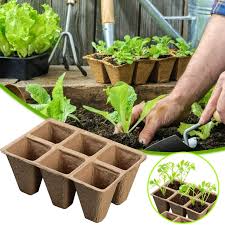
The Benefits of Biodegradable Seedling Pots
Biodegradable seedling pots are an eco-friendly alternative to traditional plastic pots for starting plants from seeds. These pots are made from organic materials that break down naturally over time, reducing waste and minimizing environmental impact. Here are some key benefits of using biodegradable seedling pots:
- Environmentally Friendly: Biodegradable seedling pots are made from materials such as peat, wood pulp, coconut coir, or rice hulls that decompose easily in the soil. This helps reduce plastic waste in landfills and oceans.
- Promotes Healthy Plant Growth: Biodegradable pots allow roots to grow freely and penetrate the pot walls, preventing root-bound plants. When transplanted into the ground, the pot breaks down, allowing roots to establish quickly in the soil.
- Convenient and Easy to Use: Biodegradable seedling pots can be planted directly into the ground without disturbing the plant’s roots. This eliminates transplant shock and saves time during planting.
- Cost-Effective: While biodegradable seedling pots may be slightly more expensive than plastic pots upfront, they save money in the long run by eliminating the need to purchase separate containers for planting and transplanting.
- Versatile: Biodegradable seedling pots come in various sizes and shapes to accommodate different types of plants. They can be used for starting seeds indoors or outdoors, making them suitable for a wide range of gardening applications.
In conclusion, biodegradable seedling pots offer a sustainable and practical solution for gardeners looking to reduce their environmental footprint while promoting healthy plant growth. By making the switch to biodegradable pots, gardeners can contribute to a greener future for our planet.
7 Essential Tips for Using Biodegradable Seedling Pots
- Choose biodegradable seedling pots made from materials like peat, paper, or coconut coir.
- Ensure the seedling pots are certified as biodegradable and eco-friendly.
- Avoid using plastic seedling pots to reduce environmental impact.
- Plant the entire biodegradable pot into the soil when transplanting to prevent root disturbance.
- Keep the seedling pots moist to help them break down more easily in the soil.
- Store biodegradable seedling pots in a dry place to prevent premature decomposition.
- Consider DIY options for making your own biodegradable seedling pots from newspaper or cardboard.
Choose biodegradable seedling pots made from materials like peat, paper, or coconut coir.
When selecting biodegradable seedling pots, opt for options crafted from materials such as peat, paper, or coconut coir. These natural materials are sustainable and eco-friendly choices that break down easily in the soil, reducing waste and benefiting the environment. By choosing biodegradable seedling pots made from peat, paper, or coconut coir, gardeners can promote healthy plant growth while minimizing their ecological impact.
Ensure the seedling pots are certified as biodegradable and eco-friendly.
When choosing biodegradable seedling pots for your gardening needs, it is essential to ensure that the pots are certified as truly biodegradable and eco-friendly. Look for certifications or labels that guarantee the materials used in the pots will break down naturally without harming the environment. By selecting certified biodegradable seedling pots, you can be confident that you are making a sustainable choice that aligns with your commitment to environmental conservation and responsible gardening practices.
Avoid using plastic seedling pots to reduce environmental impact.
To minimize environmental impact, it is advisable to steer clear of plastic seedling pots and opt for biodegradable alternatives instead. By choosing biodegradable seedling pots over plastic ones, gardeners can significantly reduce waste and contribute to a more sustainable gardening practice. These eco-friendly pots break down naturally, eliminating the need for plastic disposal and helping to protect the environment for future generations. Making the switch to biodegradable seedling pots is a simple yet impactful step towards promoting a greener and healthier planet.
Plant the entire biodegradable pot into the soil when transplanting to prevent root disturbance.
When transplanting seedlings grown in biodegradable pots, a helpful tip is to plant the entire pot into the soil to prevent root disturbance. By doing so, the roots can seamlessly grow through the pot walls and into the surrounding soil without being disrupted. This method not only saves time and effort but also promotes healthier root development and minimizes transplant shock for the seedlings. Embracing this practice ensures a smooth transition for your plants from pot to garden bed while also supporting sustainable gardening practices through the use of biodegradable materials.
Keep the seedling pots moist to help them break down more easily in the soil.
To ensure that biodegradable seedling pots break down effectively in the soil, it is important to keep them moist. By maintaining adequate moisture levels in the pots, the organic materials can decompose more easily, allowing the roots of the plant to penetrate the pot walls and establish themselves in the soil seamlessly. This simple tip not only promotes healthy plant growth but also supports the eco-friendly nature of biodegradable seedling pots by facilitating their natural breakdown process.
Store biodegradable seedling pots in a dry place to prevent premature decomposition.
To ensure the longevity of biodegradable seedling pots, it is essential to store them in a dry place to prevent premature decomposition. Moisture can accelerate the breakdown process of these eco-friendly pots, potentially compromising their structural integrity before they are ready to be planted. By keeping biodegradable seedling pots in a dry environment, gardeners can maintain their quality and effectiveness until they are used for planting seeds or transplanting seedlings.
Consider DIY options for making your own biodegradable seedling pots from newspaper or cardboard.
Gardeners looking to embrace sustainability and reduce waste can explore do-it-yourself (DIY) options for creating biodegradable seedling pots using readily available materials such as newspaper or cardboard. By repurposing these items into plant containers, gardeners can not only minimize their environmental impact but also save money on purchasing traditional pots. Crafting homemade biodegradable seedling pots is a creative and rewarding way to nurture plants from seeds while contributing to a greener gardening practice.
